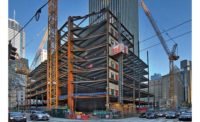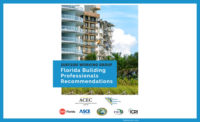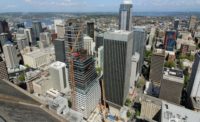Structural Engineering
Steel Group Publishes Design Guide for SpeedCore
Modular shear-wall core system touted as safer, simpler and faster to build than a concrete core

SpeedCore slashed 40% off the construction schedule for the 850-ft-tall Rainier Square Tower in Seattle, according to the structural engineer.
Photo courtesy Magnusson Klemencic Associates
Structural engineers interested in a novel high-rise shear-wall core system of composite steel-plate modules, touted as being faster, safer and less costly to build than a concrete core, now have a design tool. The American Institute of Steel Construction last week released a 258-page guide to facilitate design of the system, which group dubbed SpeedCore.
Design Guide 38: SpeedCore Systems for Steel Structures is intended for use with the 2022 AISC Specification for Structural Steel Buildings, also published this month, and the 2022 AISC Seismic Provisions for Structural Steel Buildings, due out in late spring.
“The timing is perfect,” says Amit H. Varma, the guide’s lead author, referring to the three documents coming out within months of each other. “For the first time, an engineer doesn’t have to be concerned about which code” to use to satisfy the building official when designing a SpeedCore building, he says. Varma is also director of the Bowen Laboratory for Large-Scale Research at Purdue University, which conducted many of the tests on SpeedCore that are the foundation of the guide.
Further, the AISC specification and seismic provisions, both consensus documents, are part of the design bible on structural loading, known as ASCE/SEI 7-22, published by the American Society of Civil Engineers Structural Engineering Institute. “The documents empower the engineer to design in accordance with ASCE 7,” which simplifies the approval process, Varma explains.
SpeedCore is a prefabricated system of shop-welded cross-tied steel-plate modules. In the field, modules are stacked like Legos, welded together and filled with aggregate-free high-strength concrete that has no reinforcing steel.
AISC and others claim a SpeedCore building is faster, simpler and safer to construct than a concrete core connected to a perimeter steel frame.
There are two SpeedCore buildings that demonstrate the advantages, both engineered by Magnusson Klemencic Associates, which pioneered the system. “The interest in the system has grown as has the comfort level, knowing others have gone first and second,” says Ron Klemencic, MKA chairman and CEO.
According to the firm, using SpeedCore on the 850-ft-tall Rainier Square Tower in Seattle, which opened in 2021, slashed construction time 40% by shaving 10 months off the structure’s erection schedule. Using SpeedCore on the 300-ft-tall 200 Park Avenue in San Jose, Calif., which will be finished in May, cut three months off the schedule.
Still, SpeedCore is not catching on like wildfire. One structural engineer, who declined to be identified, says it is too expensive and calls it a “niche system.”
Even Klemencic says “it is not for every building but is a good option for some.”
Tremendous Interest in SpeedCore
AISC will not reveal even the number of structural engineers investigating the system, let alone their names, citing nondisclosure agreements. But Varma says there is “tremendous interest” in SpeedCore, even compared to one year ago.
“It is definitely being considered by multiple offices,” he says. Also declining to offer specific firm names, Varma says that, with AISC's permission, he had already sent the draft of the design guide to about a dozen engineers.
MKA reviewed and edited the guide, which is intended to facilitate design of both shear walls and elevator core walls. The document discusses the behavior, design and detailing of uncoupled and coupled SpeedCore walls—all field welded—under wind, seismic and fire load combinations.
Coupled shear walls consist of modules with vertical openings, mostly for doorways, connected by horizontal link beams. Uncoupled shear walls do not have vertical openings. SpeedCore walls can be planar, C-shaped or I-shaped.
AISC says it has already spent or is committed to spending a total of $1.135 million on SpeedCore research. In addition, other organizations have contributed about $1.6 million, with $1.1 million coming from the Charles Pankow Foundation.
Research on Field-Bolted Systems
Research on the use of field-bolted SpeedCore systems—not appropriate for seismic zones—is ongoing at the University at Buffalo and Purdue. The research documents will initially serve informally as an addendum to the design guide and will then be incorporated into any future editions of the guide, says AISC.
Varma expects to complete the research on field bolting, which includes the quantity, spacing and size of the bolts, by the end of the summer. The seven bolted-splice connection tests on an uncoupled wall already completed went “very well,” he says. “We had expected a certain amount of strength and deformation and the tests exceeded our expectations to a certain extent,” he adds.
Fire tests on bolted connections of the floor system to the wall, also set to conclude this summer, are going well. The system performed as expected in the two fire tests already done, says Varma.
MKA has completed design—and the peer review is done—for a bolted SpeedCore system for a 35-story office building in Boston’s Back Bay neighborhood. “The building permit is available” and the project is “shovel ready” when the developer, Boston Properties, decides to begin construction, says Klemencic. MKA also is beginning design of a 75-story SpeedCore building in South Korea.
The design guide is in the public domain. “We have created a body of knowledge that can be very inviting for engineers to consider the SpeedCore system for their next project,” Varma says. “The dream is that more people start looking at the documents and say, ‘Yes, I think I can do this,’” he adds.
“The next step is to make this system as accessible as possible to all engineers,” says Klemencic.








